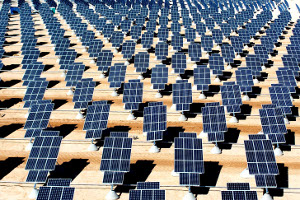 Words matter to scientists. The scientific method is a structure through which scientists test theories through experiment, and then share the results with other scientists.
Words matter to scientists. The scientific method is a structure through which scientists test theories through experiment, and then share the results with other scientists.
Scientists are figuring out how to squeeze more electricity out of photovoltaic (PV) panels. PV panels take the sun’s energy and convert it into electricity. The sun’s energy is abundant, but in order for solar electricity to compete with cheaper forms of electricity, such as that produced from highly polluting coal-fired power plants, PV panels have to be more efficient. And they need to be cheaper. Higher efficiency gets you more power for the same area, which saves on costs. But higher efficiency means more expensive PV modules.
The efficiency of PV panels is measured by the percentage of sun energy falling on the panel that is converted to electricity. According to the National Renewable Energy Laboratory (NREL), commercial PV panels today range in conversion efficiency from about 7% to 17%. Compare that to the efficiency of a typical fossil fuel power plant that has a conversion efficiency of about 30%. That means that about 30% of the energy in coal or natural gas gets converted to electricity. The rest is wasted as heat as the fuel is burned to create steam, which is used to turn a turbine, and it is wasted in the cooling tower where the steam condenses back to liquid water. There is some loss of energy, called transmission losses, as the electricity goes from the power plant to your house. With PV cells, the transmission losses are close to zero, since the electricity doesn’t have far to travel. On the other hand, the inverter required to convert the DC from the cells to AC to connect to the grid does cause some loss.
Typical PV cells are made from crystalline silicon or other semi-conductor materials. One advance in the technology is the creation of thin film PV cells made of the same, or similar materials. These cells use less material than crystalline silicon cells, and so are cheaper to make, and they are more flexible—some are made to act like roofing shingles, only they produce electricity as well as keep you out of the weather at home. But thin film PV is generally less efficient at converting sunlight to electricity compared to the more expensive crystalline silicon PV cells.
Another advance in the technology is layering materials that convert different parts of the spectrum of light into electricity. NREL has made some cells that are more than 30% efficient, but they're very expensive—maybe suitable for use in space where size and weight are critical.
Scientists at Lawrence Berkeley National Laboratory (LBNL) are trying to develop materials that are abundant and also suitable for affordable large-scale use in PV cells. The scientists are currently doing research with bismuth ferrite, a ceramic material that is both ferroelectric and ferromagnetic, and which has some interesting photovoltaic properties that operate on the nanoscale. The material could possibly be used in PV cells that are much more efficient than what is commercially available today, but that is less expensive.
